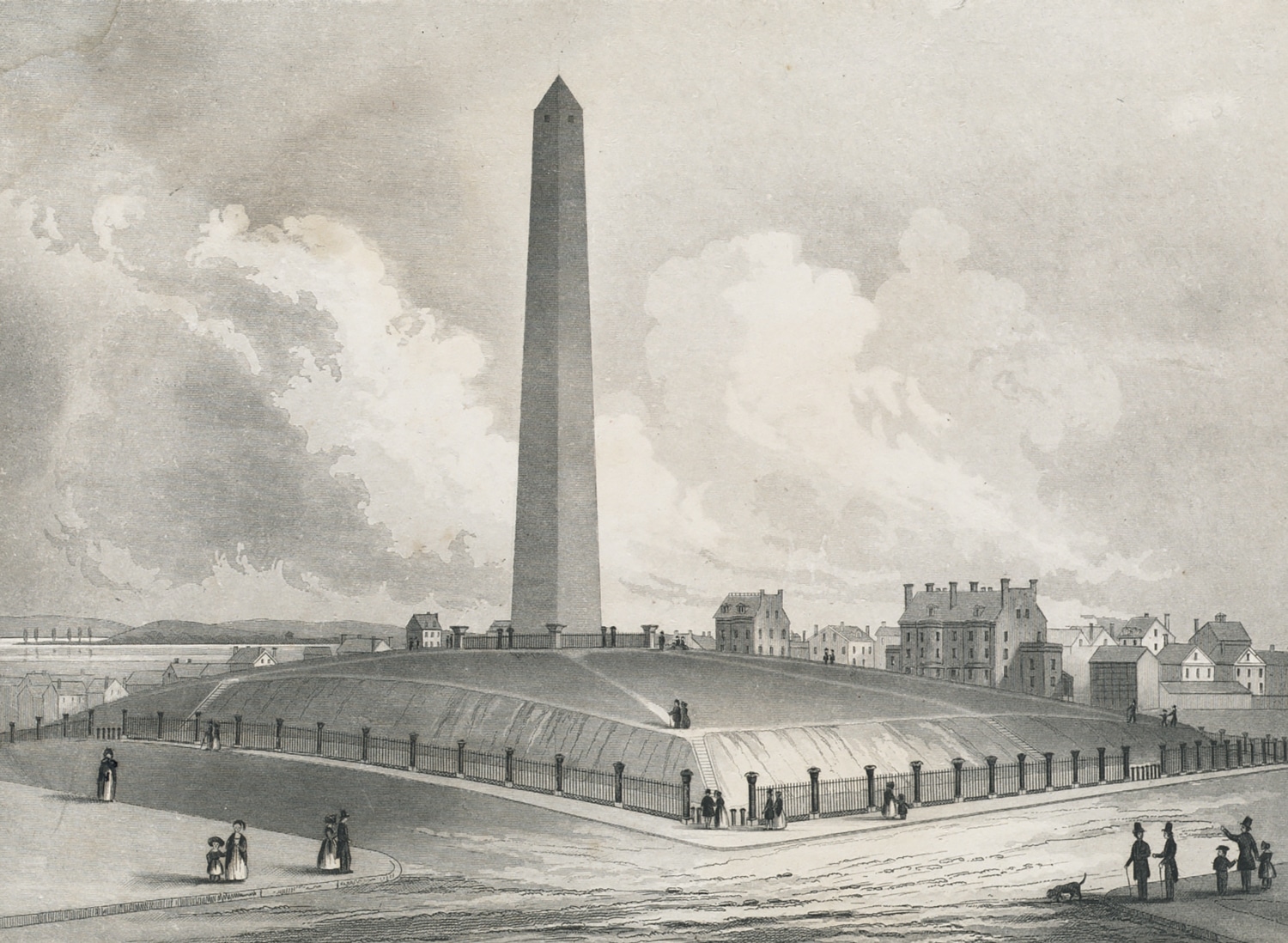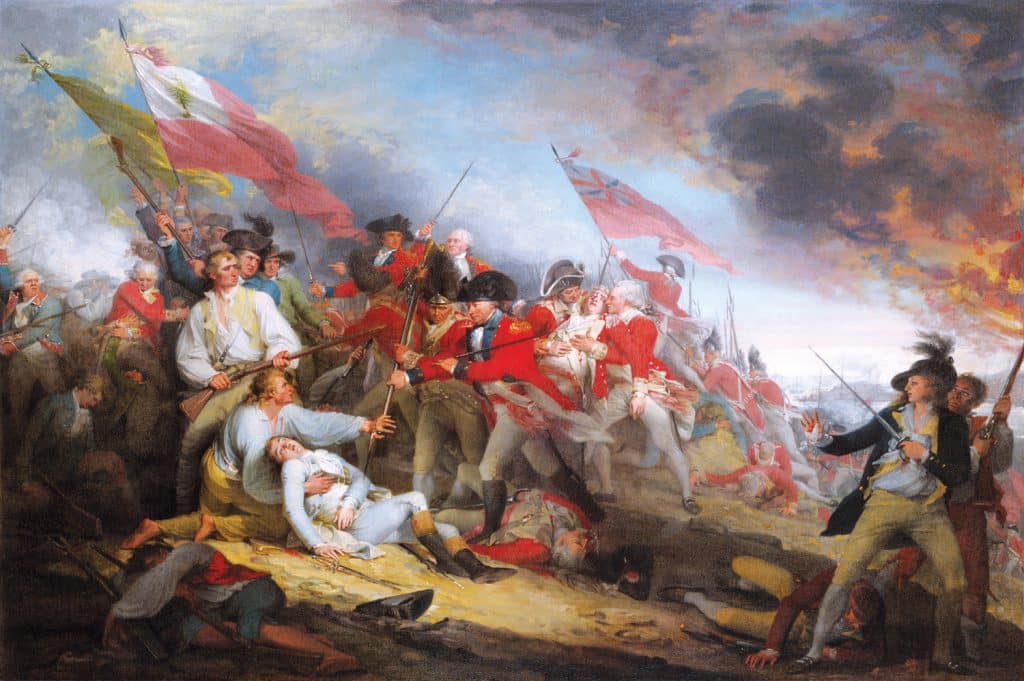Boston’s Bunker Hill Monument: A Legacy of Sacrifice, Memory, and Service
Soaring 20 stories above the Revolutionary War’s first major battle site, the height of the Bunker Hill Monument never fails to catch the eye. But getting at its depth is another matter altogether.

Coffee By Design | Portland, Maine
Photo Credit : Katherine KeenanIn David Hannigan’s earliest memories, he is climbing the stairs inside the Bunker Hill Monument with his father, Tommy. Up and up they go, following the 294 tightly twisting steps, big steps for a boy 4 or 5 years old.
“Was that hard?” his father asked him.
“Yes,” said David.
“Imagine how hard it was for the men fighting here,” his father said.
Years later, David realized how hard that climb was for his father, a veteran of World War II. “He served in the Navy and actually was badly wounded and wasn’t expected to survive, wasn’t expected to walk again. I didn’t recognize that as a child—that my father taking us up to the top of the monument was the closest thing to witnessing a miracle. His body was shattered, but his determination was greater than his disabilities.”
Tommy Hannigan wanted his son to know that “every American battle is connected to the battle fought here, and that every American who’s served their country is connected to the men who fought here.” That isn’t a line from a textbook; it’s what Tommy’s parents, who were Irish immigrants, taught him. Tommy’s parents “embraced everything that this country represented,” said David. “And I know that they expected their children to only ask one thing from the country, and that is to serve and nothing else. You had to protect the country and everything that it represents, defend the Constitution, defend the liberty of this nation. And I think my father was a very good teacher.”
It’s why David Hannigan has spent the past 10 years as a National Park Service ranger at the Bunker Hill Monument in Charlestown, Massachusetts, near his own birthplace. “After my father’s death, I found that this would be a good way to serve the country, and battle against historical illiteracy. It’s the greatest evil.”
I’ve met him near the monument on the Sunday before Bunker Hill Day, June 17, 2024, the 249th anniversary of the battle. The weekend marks Charlestown’s own village holiday (“Townie Christmas, the best day of the year,” I’m told), with a big parade, family reunions, cookouts, and, presiding over it all—but at a distance, like the monument on the skyline—what is actually being celebrated.
* * * * *
The Battle of Bunker Hill was fierce; the losses were among the worst of any battle in the Revolution. The colonists’ defiance surprised King George III and impressed Europe. The king would send more men, tens of thousands of troops. It can be argued that the American Revolution, the fight that lasted from 1775 to 1783, started on this hill. It was “perhaps the decisive Day … on which the fate of America depends,” Abigail Adams wrote to her husband, John Adams, the day after the battle.
The nation has since known other decisive days, says Hannigan—December 7, 1941, or September 11, 2001—dates that mark before and after. “I try to indicate just the tragedy that was played out here in Charlestown, with hundreds and hundreds of lives being erased in a matter of minutes, the shock that is evident in statements by both British and American leadership,” he says. In two hours of combat, the British suffered a nearly 50 percent casualty rate, with 1,054 soldiers killed or wounded. The New England militia lost an estimated 441 soldiers—dead, wounded, or captured.
We’re standing at the Massachusetts Gate on the steps to the monument park. Visitors by twos and threes pause, hold up their phones, and smile for selfies. The monument itself looks crisp and pure in the background. Dog walkers stop to pose their dogs. (Fido on the Freedom Trail.) The neighbors are coming out, setting up chairs for the parade. The first runners in the Boys & Girls Club’s Battle of Bunker Hill Road Race stream by. It’s a Sunday in the park, as fine a June day as you’ll ever find.
Just up the hill, 30 men were bayoneted to death. General Joseph Warren, Boston’s favorite doctor, took a musket ball in the face; he was memorialized as one of the Revolution’s first martyrs. As the redcoats charged uphill on their third and final assault, the militia, out of ammunition, threw rocks and swung their muskets like clubs before they retreated. The British navy shelled Charlestown, setting it ablaze.
After the battle, a British lieutenant named John Waller wrote home: “I cannot pretend to describe the Horror of the Scene within the Redoubt [fort], when we enter’d it ’twas streaming with Blood & strew’d with dead & dying Men, the Soldiers stabbing some and dashing out the Brains of others was a sight too dreadful for me to dwell any longer on.”
And today? A father tosses a Frisbee to his two little girls, a family sets up a table topped by a tower of pizza boxes. One sun worshipper lays out, lizard-like. This is the other monument: a day without war.
Men died where we picnic. The peace of the park buries the dead. Small memorial flags—the Stars and Stripes and the Union Jack, one for each fallen soldier—have been set out between the paths leading to the monument. It looks like a tulip bed, a nice touch of color.
The battle waged here was 249 years ago. And on this sunny, breezy June day, it may as well have been in the Pleistocene, the Ice Age.
* * * * *
The Bunker Hill Monument was born out of a worry that, 50 years on, America was losing touch with the Revolutionary War generation, a generation that was “united … in a common cause in defense of their rights,” as President James Monroe said on his visit to the battlefield in 1817. Monroe was seeking to unify the country after the divisive War of 1812, a war New Englanders hated.

Photo Credit : Trumbull Collection, Yale University Art Gallery
The monument was an ambitious undertaking: a statement that New England had led in battle and would lead in patriotic memory. The effort to remember rivaled what was being remembered. After construction began in 1827, the monument took 15 years to build. The first commercial horse-drawn railroad was built to move the obelisk’s massive granite blocks. Work stopped repeatedly when funds ran out. For more than five years there stood just a 37-foot-tall granite stump, a neighborhood eyesore. In debt, the Bunker Hill Monument Association sold two-thirds of the battlefield in the 1830s—a field they had saved from being cut into house lots.
Not everyone wanted a grand “national” monument. One veteran, Major Caleb Stark of New Hampshire, pleaded that those who served be given bread, not granite: “In room of giving them the bread that was solemnly promised, the debt is to be paid by a stone!!” (Service pensions were not extended to all veterans until 1832.) Others argued that an unadorned battlefield was the most powerful witness.
The battlefield, without the memorial, was a magnet. Marquis de Lafayette, hero of the Revolution and “Guest of the Nation,” visited twice on his triumphal tour of America in 1824 and 1825. The Frenchman was greeted everywhere with parades, banquets, and toasts. Temporary arches were erected for him to parade under. Temples were built out of flowers. Old veterans came forth to be greeted and embraced; Lafayette remembered their names. Congress granted him $200,000 in stock ($6.5 million today) and an entire township of land. He was the last living general of the Continental Army, the last living link to George Washington. He visited Mount Vernon and exited Washington’s tomb in tears. We have no comparable heroes.
Lafayette’s tour revived interest in honoring the Revolution by saving Independence Hall (it had been partially demolished, and the rest threatened to come down) and preserving the battlefields at Yorktown and Bunker Hill. His first visit to Bunker Hill was emotional, said witnesses. “Sir, I tread this holy ground,” said Lafayette, “where the blood of American patriots … early and gloriously spilled, aroused the energy of three millions, and secured the happiness of ten millions, and of many other millions of men in times to come.” In Paris, Lafayette’s coffin is surrounded by soil gathered from this battlefield.
To consecrate this “holy ground,” Lafayette returned to lay the cornerstone for the monument, even though there was no design yet and the foundation would wait another two years. Almost 100,000 turned out—double Boston’s population at the time. As Lafayette rode in a long parade, his passage was marked by the crowds on the street, in windows, on roofs and chimneys, waving white handkerchiefs. Lafayette’s tour had relieved the country from a fractious presidential campaign. “All the discord” was forgotten, said James Fenimore Cooper, “and nothing was thought of but Lafayette and the heroes of the Revolution.”
When the Bunker Hill Monument was finally dedicated in 1843, Daniel Webster, the great orator and statesman, said it had one meaning. It stood for “one country, one constitution, and one destiny.” That was the wish; that was what these Americans, in the decades before the Civil War, were trying to conjure. Webster’s sentiments, it was said, were “the very household words of a nation.”
* * * * *
Several days a week in the summer season, hourly from 11 a.m. to 3 p.m., visitors gather in front of the monument to hear a park ranger talk about the “Decisive Day.” The rangers will talk to two people or 200—no matter. They will welcome the group by asking where they’re from, then deftly sketch the prelude to war, the costly battle, and what it all means. They will set out a battlefield map, and a map showing the shoreline of colonial Boston. Talking for just a few minutes they will build a timeline, introduce some of the leaders of the militia, and conclude by pointing the way to the years of fighting to come.
Day after day they build the monument. They do what the 7,000 tons of granite piled up in the obelisk can’t do: They tell a story. “My grandparents came from Ireland,” says Hannigan, “and a saying in Ireland is ‘The dead are only dead if we stop talking about them.’”
* * * * *
The monument’s architect got the first—and really the last—word on his design. Horatio Greenough was a Harvard student barely in his 20s when he entered the competition to design the monument. Among the 50 entries there were many towering classical columns and columns with urns, but Greenough chose an obelisk, an Egyptian form considered the proper way to proclaim the eternal memory of the dead. He would go on to study in Italy, becoming America’s first sculptor. (His Washington statue, exposing the founding father’s torso, was scandalous.)
Greenough’s design, as built, is spare—there are no names, no laurels in stone, no urns, no statues or busts. The Bunker Hill Monument Association considered adding names but decided that plain stone was a better collective tribute: All the soldiers, living and dead, were united in one cause, the new republic, out of many, one.
Greenough said, “The obelisk has to my eye a singular aptitude in its form and character to call attention to a spot memorable in history. It says but one word, but it speaks loud. If I understand its voice, it says, Here! It says no more.”
The Bunker Hill Monument just marks the spot—Here. It doesn’t tell us what to think, or even offer a line of narrative. The story of Bunker Hill and the Revolution has to be earned, in each generation, just as David Hannigan’s father taught him, step by step.








I was able to visit the Bunker Hill monument a few years ago. It was significant for me because I had an ancestor who fought and died there He was a Great Grand Uncle from Hollis NH. He was Ebenezer Youngman. His father a grandfather and all his other brothers one my grandfather all went on to fight in the revolution .They all survived .
The article brought back memories–I grew up in Charlestown, blocks from the monument, went to high school across the street, and had many picnics on the lawn. The monument itself, was the true center of our town. However, something was missing from this article. The actual battle was not fought on Bunker Hill, but Breed’s Hill. Confusion over names during the years led to the naming of another site, close by (Bunker Hill)instead of the correct and actual battlefield.
What this article does not mention is the current Bunker Hill monument, built 50 years after the battle, is actually the SECOND monument. In 1794, King Solomon’s Lodge of Masons erected the first monument on Bunker Hill on land donated by Brother Benjamin Russell for that purpose. Constructed of wood, it was “A Tuscan pillar, 18 feet in height placed on a platform 8 feet high, 8 feet square, and fences around.”
This first monument on Bunker Hill was built in “Memory of Joseph Warren and his associates who were slain on this memorable spot June 17th, 1775”. The Lodge continued to maintain this Monument until the formation of the Bunker Hill Monument Association.